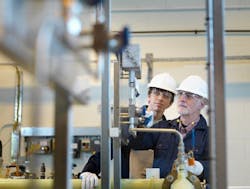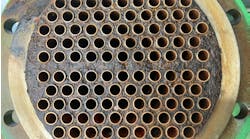Chemical manufacturers are able to collect a wealth of production data but effectively using those data to improve reliability remains a challenge for many firms. However, some operating companies such as Salalah Methanol Company (SMC), Honeywell Performance Materials & Technologies (PMT) and BASF are making the most of their data.
John Harrison, Toronto-based senior solution specialist for software provider SAP, sums up the general situation: “Our chemical customers told us that they had been collecting operational information for years and they believed that there was ‘gold’ in the data, but they lacked the capability to quickly bring multiple sources of data together and to transform the data into actionable information.”
So two years ago, SAP teamed up with Rolta, Alpharetta, Ga., to tackle this situation. Key to the relationship is Rolta’s OneView software that is designed to quickly transform operational data into information, says Harrison.
Figure 1. Salalah Methanol Company sought to increase reliability by getting a unified enterprise view of its information. Source: SMC.
A project carried out at SMC, Aquad, Oman, provided an early success for the partnership. In 2013, SMC decided it wanted to improve operational excellence, including reliability, by increasing transparency and cross-functional visibility, and by getting a unified enterprise view of its information (Figure 1). It selected SAP Business Objects and Rolta’s OneView. The companies identified 107 overall key performance indicators (KPIs). Of these,14 solely focused on reliability and maintenance, e.g., covering preventative maintenance compliance, preventative maintenance overdue, planning effectiveness, backlog of work orders, number of breakdowns, maintenance budget compliance, inspection compliance variance, and availability of reliability instruments.SMC notes the immediate benefits of the five-month project, which was completed in 2014, included automating all business-critical reports, standardizing KPI definitions, minimizing efforts required for reporting, and achieving better transparency and visibility of performance. It also has reduced operational and process failures.Over the longer term, the company hopes to improve regulatory compliance and operational excellence while maintaining a strategy of continuous improvement across processes and procedures.SMC says one of its key takeaways from the project is how powerful its capabilities are now, both in terms of compatibility with cutting-edge developments such as the SAP HANA relational database, and of support for the latest technologies such as predictive analytics.In addition, the strategy has helped SMC break production records: in January the company announced a new peak output of 5 million metric tons/y of methanol.The strategy an operating company uses for its data depends upon where that company is in the operational excellence cycle, notes Houston-based Richard Martin, senior vice president of engineering design and operations solutions for Rolta. “Some want to start with high-level benchmarking KPIs that cross the facility and enable executives to define metrics that reinforce collaboration and drive enterprise initiatives. Many clients have a specific business issue, for example product development or quality, that they need to address and use it as a quick success to provide predicted benefits, which in turn funds the rollout of a transformation initiative. Other companies are very focused on product development or quality, for example. So what is required varies on a case-by-case basis — but as a whole the industry appreciates that there is value here.”Figure 2. Defining key performance indicators isn’t always straightforward. Source: SAP.
$1.2 Billion Impact
The PMT Group of Honeywell, Morristown, N.J., which manufactures a diverse range of products including specialty chemicals, films, nylon, catalysts and fluorine products at 42 sites, began a maintenance excellence program in 2005. By 2013, this had reduced maintenance costs by 16% and raised overall equipment effectiveness (OEE) to 82% from 70% across the plants. This translates to over $1.2 billion of additional operating income across the group over the period.
In 2006, the PMT Group’s senior leadership began to fully integrate maintenance and reliability excellence into the five-year planning cycle as a core strategic business lever. Since 2007, the group has considered increases in capital expenditures in growing markets only if the plants have reached their peak sustainable OEE.
Initially, the PMT Group set out to assess the most strategically leverageable sites, identifying the plant events that compromise OEE performance, and put together a five-year roadmap to boost OEE performance. Today, these strategic sites collect daily and monthly OEE gap data, which are accumulated for justifying discrete projects focused on the various issues that impact OEE. These include: operations and maintenance work processes, equipment reliability, process technology, and supply chain performance that will yield measureable growth in OEE.
“Bottom line, driving OEE through improved maintenance and reliability programs, including predictive maintenance and a host of other analytics, for the most-business-critical equipment is the key to effective reliability results. Common sense, you say, but creating the clear line of sight to these equipment then installing the technical and management systems to drive improvement accountabilities is the perplexing part of achieving business-correlateable results,” explains Richmond, Va.-based Stan Grabill, who until recently was maintenance and reliability director for the PMT Group and now is principal reliability consultant for Honeywell Process Solutions.
“PMT learned huge lessons through deploying at a highly-visible pilot site those ‘lean maintenance’ principles of standardization of work processes and KPIs. We learned that the cycle took 15–18 months to fully realize the cultural transformation to a proactive partnership between maintenance and operations,” he adds.
Work backlog shrank to a manageable 5–7 weeks from 16+ weeks. Overtime dropped to less than 10% from ~18% in most cases. Supplemental contract labor was reduced. Predictive and preventative maintenance increased to ~27% from ~12% of total maintenance man-hours. Compliance with weekly scheduled maintenance activities rose to ~79% from ~44% while schedule loading of manpower to work planned jobs rose to 81% from ~53%.
“While such predictive and preventative maintenance techniques have been around for many years — 30 or more — the nature of siloed work practices at PMT resulted in not leveraging the equipment condition information generated by reliability and maintenance that they were giving us,” he says.
However, standardizing maintenance processes and creating a proactive partnership between maintenance, operations and reliability engineering profoundly affected the effectiveness of reliability programs. Today, reliability strategies are developed and driven by two key objectives; process safety management (mechanical integrity), and a focus on equipment that impacts OEE performance.
PMT uses SAP-PM (plant maintenance) as its computerized maintenance management system. The group is looking to replace its home-grown data collection system for OEE with Honeywell’s Downtime Reporter. Meridium software manages both inspection data and instrument calibration. Grabill foresees migrating to real-time condition/performance monitoring of the most critical equipment, probably via Honeywell’s Asset Manager.
The aim is to raise OEE to 90%+, he says, adding that the company still has much to learn in applying the right improvement tools and condition-monitoring technologies to effectively raise performance for the future.
“Conditioned-based monitoring technologies, big data, statistical intelligence and collaborative platforms are evolving rapidly. Creating a company culture that encourages the practitioners to link up with technology/solution offerings will increase their competitiveness in this global economy,” he emphasizes.
Leveraging Unused Capacity
BASF, Ludwigshafen, Germany, is putting increased focus on asset reliability, partly in response to the need to take advantage of unused capacity to support its growth strategy. “Our improvement targets are well defined and a global platform dedicated to reliability optimization has been set up. This platform is based on equipment-specific technical expertise and uses internal consultants to support the implementation of its various elements,” says Peder Lindbjerg Jensen, senior maintenance consultant for engineering and maintenance at the site.
As part of this strategy, the company particularly is concentrating on implementing and optimizing bad-actor-management programs to improve asset reliability and effectiveness. Together with root cause analysis, these programs are seen as absolutely central elements to BASF’s reliability improvement efforts.
Alongside techniques such as loss analysis and reporting, root cause analysis, failure mode and effects analysis, spare parts management, KPIs and benchmarking, and predictive analysis — all important tools — the company is using its internal consultants to help plant personnel understand and improve the transparency of data in an ongoing review of existing preventative-maintenance programs.
BASF currently uses internally developed software to drive improvements but now is evaluating more powerful commercial software as part of this review process, Jensen admits.
One big success is the eight-year risk-based-management (RBM) project at the Ludwigshafen site, he notes. “This tool has clearly been a success story for BASF and there are a number of examples where risk-reducing measures have greatly supported our operations, including reliability. However, we still have a long way to go in the implementation of RBM and the corresponding actions needed to meet the full potential of this project,” he stresses.





